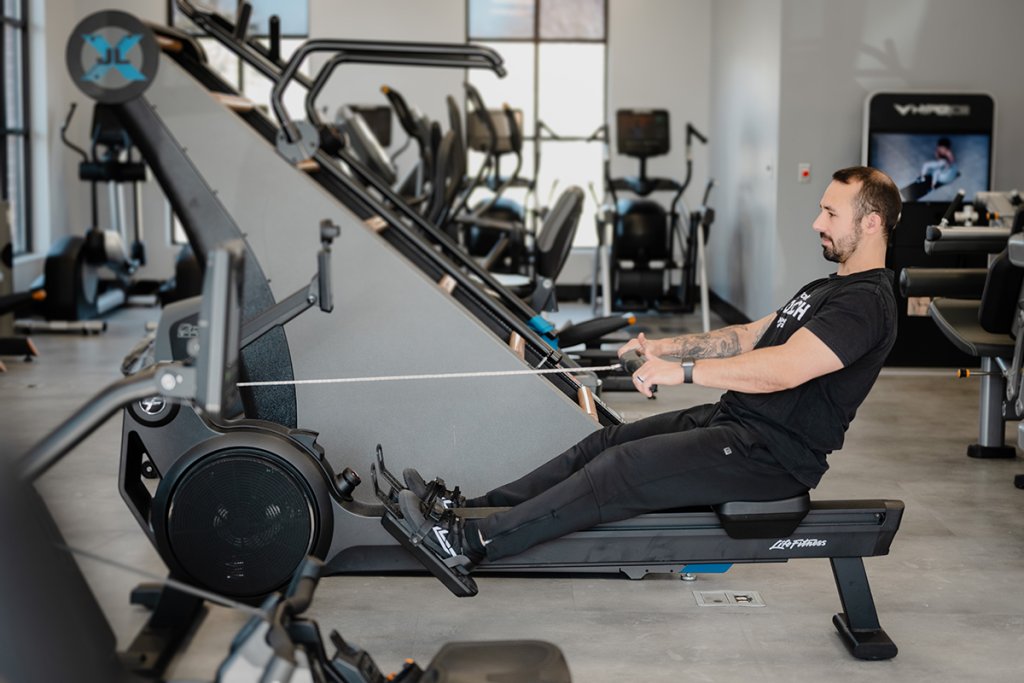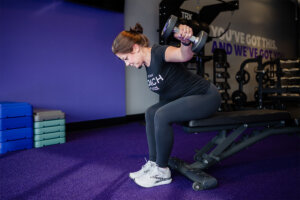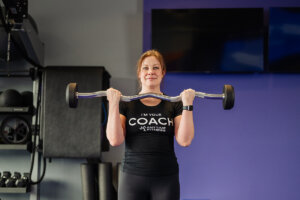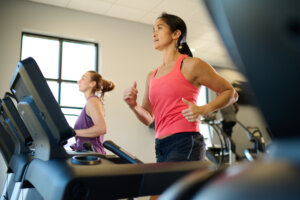Let’s talk about one of our favorite pieces of gym equipment: the rowing machine. With the proper technique, rowing machines are a powerful and effective workout tool, whether your fitness and health goals involve building strength through high-intensity workouts or you just want to stay in shape.
If you’re unfamiliar with the rower, it can be an intimidating machine, but we’re here to help. Our 21-day exercise program will help you master the rowing machine and get the most out of your workout.
The inspiring history of rowing
Rowing has been around for centuries. Some say the rowing machine got its start in Greece during the fourth century and was used as a method for training soldiers, while other sources point to evidence of its inception many years later. We’re not here to split oars over when rowing was first introduced though, so let’s skip to 30 years before it arrived at the Olympics — when the first patent was introduced.
In 1872, a 10-year-old boy named W.B. Curtis contracted tuberculosis. Curtis’ tragedy turned into his greatest inspiration. Instead of falling victim to the disease, he worked to become stronger — by rowing. He created a makeshift rowing machine with a flywheel, chain, and handlebars, all of which are still at the heart of modern rowing machines.
Today's rowing machines
It wasn’t until the 1970s that weights were added to rowing machines to create tension, and in the ’80s, customizable resistance levels were incorporated. A digital monitor was added in the 1990s.
Today, there are many different types of rowing machines. isn’t just one type of rowing machine. But the bottom line is this: There’s a rowing machine for nearly every fitness goal, and any of them will give you a great full-body workout that helps increase heart rate, work the cardiovascular system, burn fat and calories, and so much more.
The benefits of rowing workouts
Rowing machines are a versatile workout machine that can be used as a warm-up before other exercises, a cooldown, an endurance builder, or as a complete high-intensity workout. Here are some of the reasons we love working out on the rower.
Rowers are easy to use — once you know how
The rowing machine uses just one basic movement to unlock countless workout benefits, including:
- Improved cardiovascular health
- Increased endurance
- Reduced stress levels
- Greater flexibility and mobility
- Better circulation
Rowing is a full-body workout
The rowing machine works every part of your body — arms, legs, core, and back — helping you pump up your heart rate, burn calories, and build muscle mass at the same time.
Rowing is low-impact
Rowing workouts are low-impact, but they bring big results. Unlike other cardio machines, rowing machines are easy on the joints, like your hips and knees. That’s why rowing is generally well-suited for gym-goers of all ages, abilities, and fitness levels.
Rowing improves posture
Rowing exercises fight against tech neck and back pain that come from sitting down for extended periods of time. It opens the chest and strengthens the backside of the body, including the upper back, lower back, glutes, and hamstrings. Rowing workouts correct your posture and strengthen your core, so you sit taller and straighter.
How to use the rowing machine: 4 steps
Before you get started, it’s important to maintain proper form while you use the rowing machine and to understand how it works. Keep these two tips in mind as you get set up:
- Secure the foot straps over the widest part of your feet to avoid unnecessary motion and maintain stability.
- Use a wide grip on the handlebars — this works your back and shoulder muscles and prevents injury.
Note: Most rowing workouts are based on distance, so rowing machines have screens or odometers that display the distance you’ve rowed in meters (m).
Rowing step 1: The catch
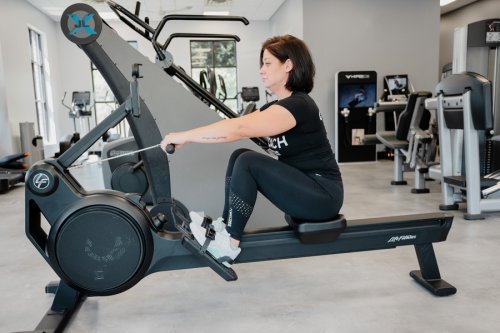
To begin rowing, start close to the front of the machine with your knees tucked tight into your body, your torso leaned slightly forward, and your arms straight out in front of you, gripping the handlebars.
Rowing step 2: The drive
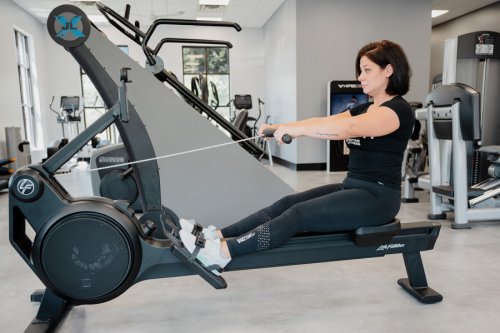
Next, push away from the base of the rowing machine with your legs explosively. Keep your arms straight out and engage your core as you push away, keeping your back straight.
Rowing step 3: The finish
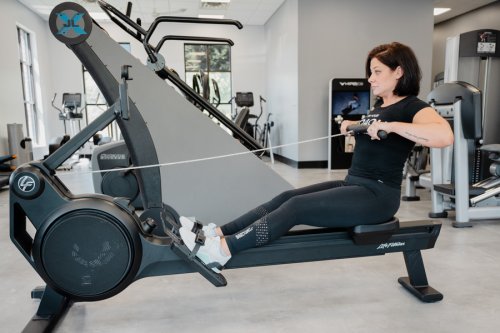
Keeping your core engaged and legs extended, lean back slightly and pull the handlebar toward your body. Avoid pulling your arms up above your shoulders.
Rowing step 4: Recovery
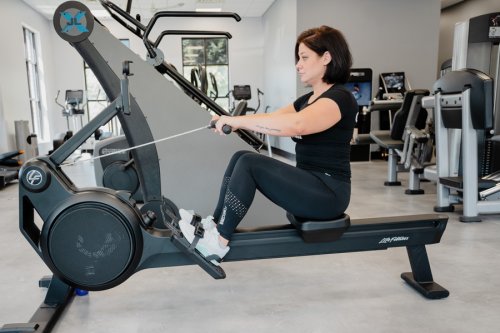
Return your body to the start position with control, getting ready to repeat the movement and complete the next row.
The full rowing technique: One fluid motion
When you put all four steps together, the final result should be one fluid rowing motion. Remember: Don’t rush your rows — focus on mastering the technique first to prevent injury and get a more effective workout.
Aim for a count of three seconds from the starting position as you stretch away from the bottom of the rower, and four seconds as you come back in and finish the movement. The extra count on the return should be focused on the legs.
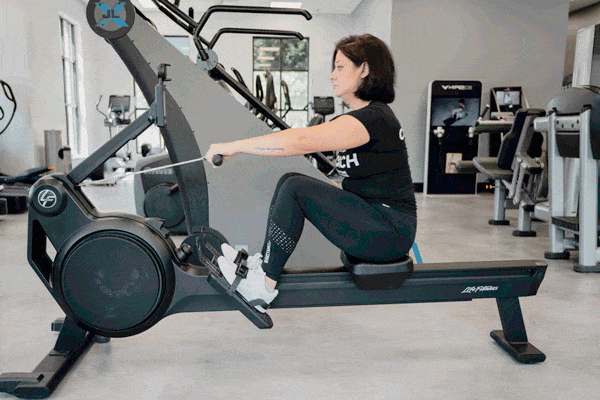
The Ultimate 21-Day Rowing Machine Workout Plan
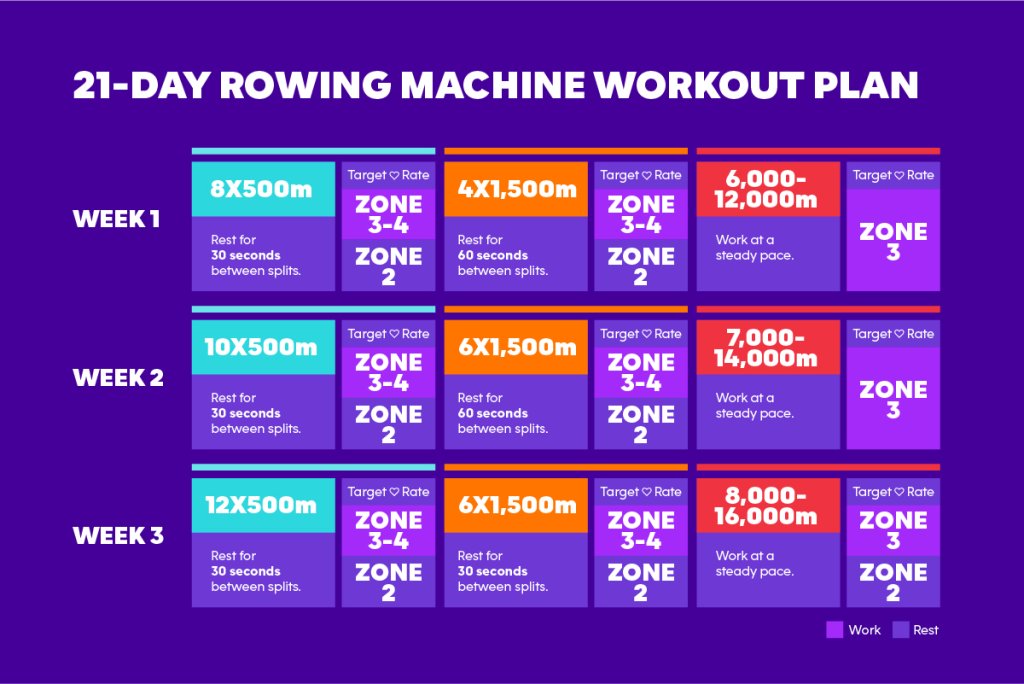
With the proper form covered, you’re ready to take on this 21-day workout plan designed to help you get the most out of the rowing machine. We’ll be using three types of workouts to focus on different goals, and we’ll be incorporating heart rate training.
Breaking down the workouts
The 21-day rowing workout plan consists of three rowing workouts per week, each varying in intensity and length:
- Workout A: The goal is to focus on short bursts of speed. Try to row at your fastest pace during each sprint. It’ll make the recovery time feel even sweeter.
- Workout B: You’ll go longer between breaks to help you hone in on a base pace with a consistent tempo.
- Workout C: To build endurance, try to keep moving for the entire workout, even if it means rowing at a slower pace. Think: jog vs. run, but for rowing.
Heart rate training
This workout plan uses heart rate zones to guide the intensity of work. Here’s a basic guide to help you get started:
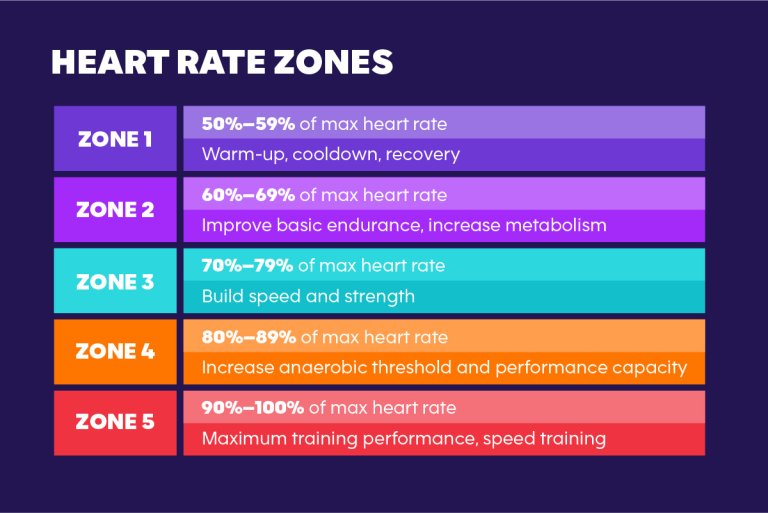
Your heart rate is divided into five zones based on your maximum heart rate, which can be calculated by subtracting your age from 220. For example, the estimated maximum age-related heart rate for a 30-year-old would be 190 beats per minute (220 – 30 years = 190 bpm).
Each heart rate zone corresponds to a percentage of your maximum heart rate. When you’re performing intense exercise (Zones 3 and 4), you’re using 70%–89% of your maximum heart rate. For most of the workouts in the 21-day plan, you’ll be in Zones 3 and 4 during work, and Zone 2 (60%–69% of max heart rate) during rest.
Note: Before every rowing workout, we recommend you warm up for 3–4 minutes in Zone 2 on the rower.
Week 1 rowing workouts
Workout A: Row for 500m in Zone 3 or 4, then rest for 30 seconds with your heart rate in Zone 2. Repeat 8 times.
Workout B: Row for 1,5000m in Zone 3 or 4, then rest for 60 seconds with your heart rate in Zone 2. Repeat 4 times.
Workout C: Row for 6,000m to 12,000m at a steady pace with your heart rate in Zone 3.
Week 2 rowing workouts
Workout A: Row for 500m in Zone 3 or 4, then rest for 30 seconds with your heart rate in Zone 2. Repeat 10 times.
Workout B: Row for 1,500m in Zone 3 or 4, then rest for 60 seconds with your heart rate in Zone 2. Repeat 6 times.
Workout C: Row for 7,000–14,000m at a steady pace with your heart rate in Zone 3.
Week 3 rowing workouts
Workout A: Row for 500m in Zone 3 or 4, then rest for 30 seconds with your heart rate in Zone 2. Repeat 12 times.
Workout B: Row for 15,000m in Zone 3 or 4, then rest for 30 seconds with your heart rate in Zone 2. Repeat 6 times.
Workout C: Row for 8,000–16,000m at a steady pace with your heart rate in Zone 3.
You did it! Be sure to measure your rowing workout progress
One way to measure your progress and endurance on the rowing machine is to track your 500-meter split times. Track your 500-meter split before starting the 21-day rowing workout plan — then track it at the end to see how far you’ve come!
Remember that everyone’s starting point and abilities are different, so do what you can and build from there. The progress you’ll make is the ultimate reward!
More rowing tips and indoor rowing workouts:
Team up with an Anytime Fitness Coach to get personalized coaching and more workout plans designed just for you. Find a gym near you.
